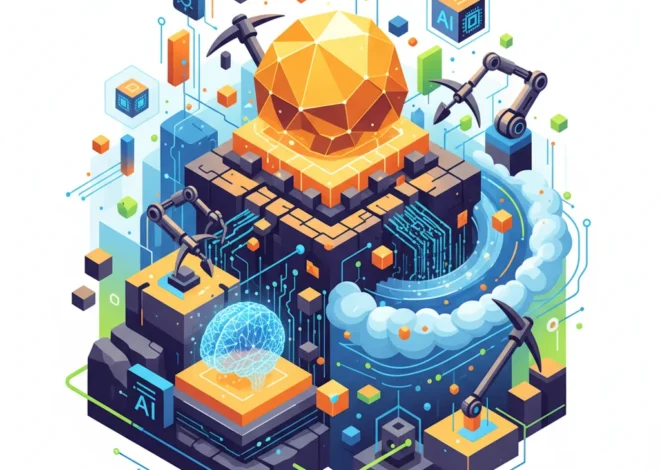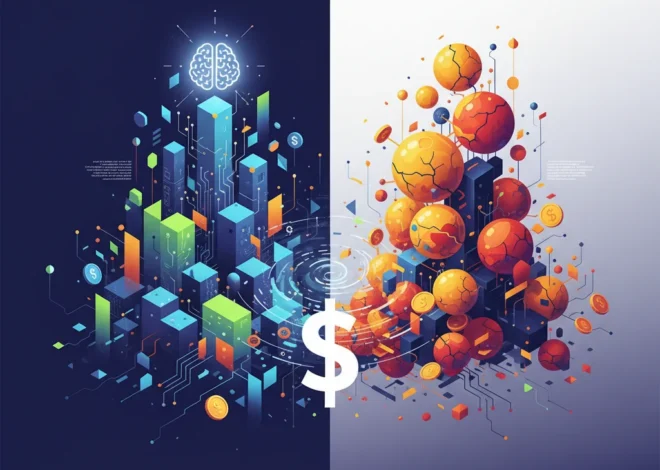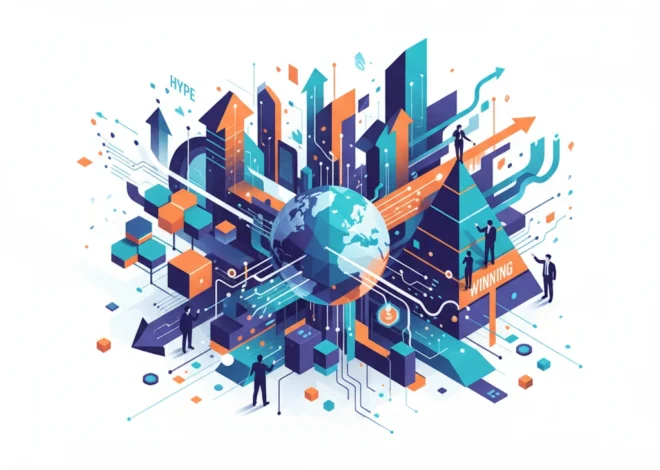
AI’s Trillion-Dollar Question: Is the Tech Boom an Echo of the Dot-Com Bubble?
We’re living through an undeniable gold rush. The words “artificial intelligence” are on every investor’s lips, in every startup’s pitch deck, and at the heart of every tech giant’s strategy. A tidal wave of capital, potentially cresting into the trillions of dollars, is flooding the AI space. It feels like an “extraordinary moment,” a technological shift on par with the internet itself. But when the person running one of the world’s largest AI powerhouses urges caution, it’s time to listen.
In a recent, candid interview with the BBC, Google CEO Sundar Pichai delivered a message of both excitement and stark warning. While hailing the current era of artificial intelligence as a monumental opportunity, he also cautioned that the investment frenzy has “elements of irrationality.” His words cut through the hype, suggesting that if this financial bubble were to burst, “no company would be immune.”
This isn’t just a casual comment; it’s a profound statement from the epicenter of the AI earthquake. It forces us to ask some critical questions. Are we witnessing a genuine technological revolution, a sustainable boom, or are we riding the wave of another tech bubble, destined to crash? What does this mean for developers, entrepreneurs, and tech professionals building their careers and companies in this super-charged environment?
Let’s unpack Pichai’s warning, compare the current climate to historical tech booms, and explore how to navigate the fine line between groundbreaking innovation and irrational exuberance.
The AI Gold Rush: Understanding the “Extraordinary Moment”
First, let’s be clear: the excitement isn’t baseless. The current AI boom is built on decades of research in machine learning and a recent explosion in the capabilities of Large Language Models (LLMs) and generative AI. This isn’t just about smarter chatbots; it’s about a fundamental shift in how we approach software development, data analysis, and creative work.
The numbers are staggering. According to the Stanford Institute for Human-Centered AI’s 2024 report, private investment in AI reached an incredible $92 billion in 2022 alone, a figure that has continued to climb with massive deals like Microsoft’s multi-billion dollar investment in OpenAI. This capital is fueling a Cambrian explosion of startups tackling everything from drug discovery and cybersecurity to automated legal services and hyper-personalized marketing.
For tech giants, AI is an existential battleground. The race to develop the most capable foundation models—like Google’s Gemini, OpenAI’s GPT series, and Meta’s Llama—is driving unprecedented investment in cloud infrastructure and specialized hardware. This has created a virtuous cycle: more investment leads to better models, which in turn unlock new applications, attracting even more investment. This is the “extraordinary moment” Pichai refers to—a genuine, technology-driven paradigm shift.
The AI Gold Rush Hits a Reality Check: Why Wall Street’s “Boring” Money is Getting Nervous
Pichai’s Warning: Are We Seeing “Elements of Irrationality”?
Here’s where the story gets complicated. When capital flows this fast, it can be indiscriminate. Pichai’s use of the phrase “elements of irrationality” is a deliberate and carefully chosen echo of former Fed Chair Alan Greenspan’s “irrational exuberance” warning just before the dot-com bubble burst in the late 1990s.
The parallels are hard to ignore. We’re seeing:
- Sky-High Valuations: AI startups with little more than a concept and a team of talented engineers are raising tens or even hundreds of millions of dollars at billion-dollar-plus valuations.
- “AI-Washing”: Companies in every sector are hastily rebranding themselves as “AI companies” to attract investor attention, often by simply integrating a third-party API.
- FOMO-Driven Investment: Venture capitalists are under immense pressure to place bets in the AI space, sometimes leading to less rigorous due diligence for fear of missing out on the next big thing.
- A Focus on Potential Over Profit: The narrative is often dominated by Total Addressable Market (TAM) and future potential, with less emphasis on current revenue or a clear path to profitability.
To put this in perspective, let’s compare the current AI boom with the dot-com bubble of the late 1990s.
| Metric | The Dot-Com Bubble (Late 1990s) | The AI Boom (2020s) |
|---|---|---|
| Core Technology | The commercialization of the internet and the World Wide Web. | Generative AI, Large Language Models (LLMs), and advanced machine learning. |
| Key Players | Netscape, Yahoo!, AOL, Pets.com, Amazon, Google (early days). | OpenAI, Google, Microsoft, NVIDIA, Anthropic, and thousands of startups. |
| Investment Driver | Belief that any company with a “.com” suffix would dominate future commerce. | Belief that AI will fundamentally transform every industry and create new ones. |
| “Irrational” Symptom | Companies going public with no revenue, based on “eyeballs” and website traffic. | Pre-revenue startups raising nine-figure rounds based on the perceived quality of their model or team. |
| Infrastructure Bottleneck | Limited bandwidth and dial-up internet access. | GPU shortages and the immense cost of training and running large models. |
If the Bubble Bursts, Who Gets Soaked?
Pichai’s warning that “no company would be immune” is a crucial point. A market correction in the AI space wouldn’t happen in a vacuum. The fallout would ripple across the entire tech ecosystem.
- Startups and Entrepreneurs: They are on the front lines and would be hit hardest. Venture capital funding, the lifeblood of the startup world, would dry up almost overnight. Companies would face “down rounds” (raising money at a lower valuation), making it harder to retain talent with devalued stock options. Many would simply run out of cash and fold.
- Developers and Tech Professionals: The red-hot job market would cool significantly. While top-tier AI researchers would likely remain in high demand, roles at less-funded startups would evaporate. The emphasis would shift from rapid hiring to efficiency. For developers, this underscores the importance of focusing on core fundamentals in programming, algorithms, and systems design, rather than just chasing the latest hyped-up framework. Adaptability will be key.
- Big Tech: Companies like Google, Microsoft, and Amazon would certainly see their stock prices fall, but they would survive. A downturn could even present an opportunity for them to acquire struggling startups and their talented teams for a fraction of their peak cost.
This potential fallout highlights a critical need for sustainable thinking. As experts have noted, the companies that survive and thrive will be those that use AI to solve tangible business problems, not just those that have “AI” in their name.
The £5 Billion Bitcoin Heist: How AI and Cybersecurity Are Battling a New Era of Digital Crime
Beyond the Bubble: The Enduring Technological Revolution
Here’s the most important takeaway: a financial bubble bursting is not the same as a technology failing. The dot-com crash was devastating for investors and many companies, but the internet itself didn’t disappear. In fact, the crash cleared out the unsustainable business models, paving the way for giants like Google and Amazon to build enduring empires on the internet’s real, transformative power.
The same will be true for artificial intelligence. Even if the investment market corrects, the underlying innovation is here to stay. AI is already delivering real value in countless areas:
- SaaS and Enterprise Software: AI-powered features for automation, data analysis, and workflow optimization are becoming standard expectations in modern SaaS products.
- Cybersecurity: Machine learning algorithms are indispensable for detecting anomalies, identifying threats, and automating responses at a scale no human team could manage.
- Healthcare and Science: AI is accelerating drug discovery, improving medical diagnostics, and helping scientists analyze massive datasets to tackle challenges like climate change.
The core technology works. The challenge is separating the real-world applications from the speculative hype. The revolution is real, even if the current stock market valuations are not.
How to Navigate the Hype: A Guide for the Savvy Tech Professional
So, how do we internalize Pichai’s warning without becoming cynical about AI’s incredible potential? It’s about adopting a mindset of critical optimism and focusing on fundamental value.
- For Developers: Master the fundamentals. While learning the latest AI APIs is useful, a deep understanding of programming, data structures, and the mathematical principles behind machine learning will make you invaluable in any market. Build things that solve real problems. A portfolio project that uses AI to automate a tedious task is more impressive than a flashy demo with no practical application.
- For Entrepreneurs: Don’t build a business on hype. Focus relentlessly on your customer’s pain points. Is AI the best way to solve their problem, or is it a solution in search of a problem? Build a sustainable business model that doesn’t rely on an endless stream of venture capital. Real revenue is the ultimate defense against a market downturn.
- For a General Audience: Learn to be a discerning consumer of AI news. Understand the difference between a real technological breakthrough and a marketing press release. Be excited about the possibilities, but remain critical of the grandiose claims.
The EU's New Intelligence Hub: A Big Data Challenge or a Cybersecurity Nightmare?
Conclusion: Building on Bedrock, Not Sand
Sundar Pichai’s comments serve as a necessary anchor in a sea of AI hype. He’s not predicting doom; he’s advocating for wisdom. The rise of artificial intelligence is truly an “extraordinary moment” that will reshape our world. But the path to that future will be volatile. History teaches us that after every gold rush, the people who truly succeed are not the ones who found the biggest nugget, but those who built the tools, the infrastructure, and the sustainable businesses that served the new economy.
The challenge for all of us—developers, founders, investors, and professionals—is to look past the “elements of irrationality” and focus on building real, lasting value. The AI revolution is here, but the future will belong to those who build it on a foundation of solid engineering, smart business principles, and a clear-eyed view of both the risks and the truly extraordinary rewards.


